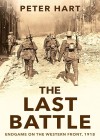The Last Battle: Endgame on the Western Front, 1918
Written by: Peter Hart
Oxford University Press, 2018,
ISBN 9780190872984, 464pp
Reviewed by: Brigadier Chris Roberts (Ret’d) AM, CSC
In 2008 Peter Hart, oral historian at the Imperial War Museum, wrote 1918: A Very British Victory, in which he covered the fighting throughout 1918 from a largely British and Commonwealth perspective. In his latest work, The Last Battle: Endgame on the Western Front,1918, Hart returns to the last year of the war with both a shorter and a slightly broader focus: addressing the last six weeks of the Hundred Days through the lens of selected offensives across the Western Front.
To set the background, the initial chapter provides an overview of the situation prior to late September 1918, covering the principal political and military issues and a synopsis of the fighting from the German Offensives in Spring 1918 to the point where the Allies were poised to strike again on 26 September 1918. From there we get into the meat of the book, where Hart blends the operational and tactical narrative with large doses of personal accounts by participants. This is the trademark of his books, in which he brings the history of the war alive with the human experience of events through the reflections, observations and thoughts of those who served, both Allied and German.
In the next nine chapters Hart weaves his cloth from the Argonne to Flanders, recounting Foch’s strategy of sequenced attacks, switching assaults from one point to another in order to keep the Germans off balance and limit their ability to employ their reserves effectively. Stepping off in this account are the Americans in the Battle of the Meuse-Argonne, then the British and Canadians at the Canal du Nord followed by the British and Belgians at Ypres and Courtrai, before slipping south again for the breaching of the Hindenburg Line at the Saint Quentin Canal tunnel by the British Fourth Army, comprising the British III and IX Corps, the Australian Corps and the American II Corps. From there we follow the British and New Zealanders to and across the Selle River before a brief interlude (Chapter 8) in which Hart provides an outline of the international situation and the machinations of the Allied and the German politicians and High Commands as the latter sought desperately to rescue something from the debacle engulfing them and the former sought to press home their advantage.
Hart wraps up the final week of fighting, focusing first on the Americans on the Meuse and then on the British and New Zealanders at the Battle of the Sambre, before reaching the ‘day of days’—11 November 1918. Here is the reaction to news of the armistice, the last few hours of combat, the tragedy of the last deaths and the poignancy and relief that flows through the words of the survivors when they learned the dreadful ordeal was over. One wonders, however, what compelled Private Henry Gunther of the American 313th Infantry Regiment to charge a pair of German machine guns in the last minute of the war, against the explicit orders of his officers and with the Germans shouting and waving him away, to become, perhaps, the last American soldier killed in action. Hart rounds off his book with an ‘Aftermath’, giving us a glimpse of what followed: the occupation of the Rhine, the clearing of the battlefields and demobilisation.
As can be seen from the offensives Hart includes, this is largely an Anglo– American–German account, in which ‘Anglo’ also includes the Australians, Canadians and New Zealanders. Conspicuous by their absence in it, though, are the French, who also participated in the endgame. For their contribution English-speaking readers should turn to the works of Robert A. Doughty and Elizabeth Greenhalgh. Nonetheless, this does not diminish what Hart has delivered. His audience is the general public of the United Kingdom, the United States, Australia, Canada and New Zealand—and he provides them with a lively, engaging and well-written story that flows from page to page. Once picked up, it will be hard to put down.
Hart is an accomplished historian displaying a sound knowledge of the war as well as its challenges and difficulties and the manner in which they were overcome. Like his other books, The Last Battle: Endgame on the Western Front,1918 embraces the human face of war within a largely operational narrative that is balanced and fair in its commentary and gives credit where credit is due. Readers will not be disappointed with his latest contribution to our understanding of both what occurred and the thoughts and experiences of those who participated—from the highest levels of command to the men in the ranks.

